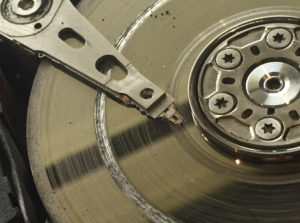 Recently, we searched for “failing hard drives” to see whether the internet was dispensing bad advice regarding drive failures (and to see if our name came up). Google’s experimental A.I. answered our question — and promptly provided instructions that could potentially cause permanent data loss.
Recently, we searched for “failing hard drives” to see whether the internet was dispensing bad advice regarding drive failures (and to see if our name came up). Google’s experimental A.I. answered our question — and promptly provided instructions that could potentially cause permanent data loss.
“If you notice noises, performance issues, or other signs of hard drive failure, you should take action quickly to save your files,” Google’s AI explains. “You can try running a S.M.A.R.T. scan or a CHKDSK scan on your disk. You can also try backing up your device.”
Granted, Google’s generative AI search results are experimental — but this is awful advice. Here’s why.
CHKDSK isn’t intended to fix hard drive issues.
CHKDSK (Check Disk) is a command-line utility included with Microsoft Windows operating systems that checks the file system and file system metadata of a volume for logical and physical errors. It can also fix some types of errors with the file system — but no software is capable of fixing failing read/write heads, damaged motors, or other hard drive components.
If you use CHKDSK on a failing hard drive, several (bad) things can happen:
- CHKDSK will attempt to create a list of errors on the disk, which requires scanning each sector.
- On a failing drive, practically every sector may be marked as an “error,” leading to widespread file corruption.
- CHKDSK will rarely permanently destroy data, but by overwriting the file system, it can greatly complicate data recovery efforts.
The bottom line: If you need the data on a failing hard drive, do not run CHKDSK. You should only use the utility if all of the following are true:
- You have a backup of all important data;
- You’re experiencing performance problems related to an improper shutdown or other logical (non-physical) issues; or
- You simply want an overview of your hard drive’s health.
Don’t treat CHKDSK as a data recovery utility. It’s for improving performance, not restoring files (though it may resolve logical data corruption in some circumstances).
Related: “Hard Disk Failure Is Imminent” Error Message: What to Know
If you notice signs of hard drive failure, follow these steps.
If your data is accessible, immediately back up important files. Try to do a targeted backup of key files/folders; creating a full clone of the drive is an intensive process and might exacerbate physical issues.
If the data is not accessible:
- Make a list of any symptoms that preceded the failure, including unusual noises (such as clicking, whirring, or grinding sounds) and error messages.
- If possible, make a list of important files or file types.
- Keep the drive powered off.
- Find a qualified data recovery provider. Physical hard drive issues must be treated in an appropriate cleanroom environment; Datarecovery.com operates cleanrooms at each of our full-service laboratories, and all of our facilities are equipped to perform hard drive data recovery.
- Remove your hard drive and package it appropriately according to your provider’s instructions. If you’re not comfortable removing components from your computer, find a computer repair shop.
Datarecovery.com offers a no data, no charge policy for all hard drive failure scenarios, which provides peace of mind as your case progresses. If we’re not able to recover the files you need, you don’t pay for the attempt.
Each case begins with a risk-free evaluation. Contact us today at 1-800-237-4200 or fill out our online case form to get started.




